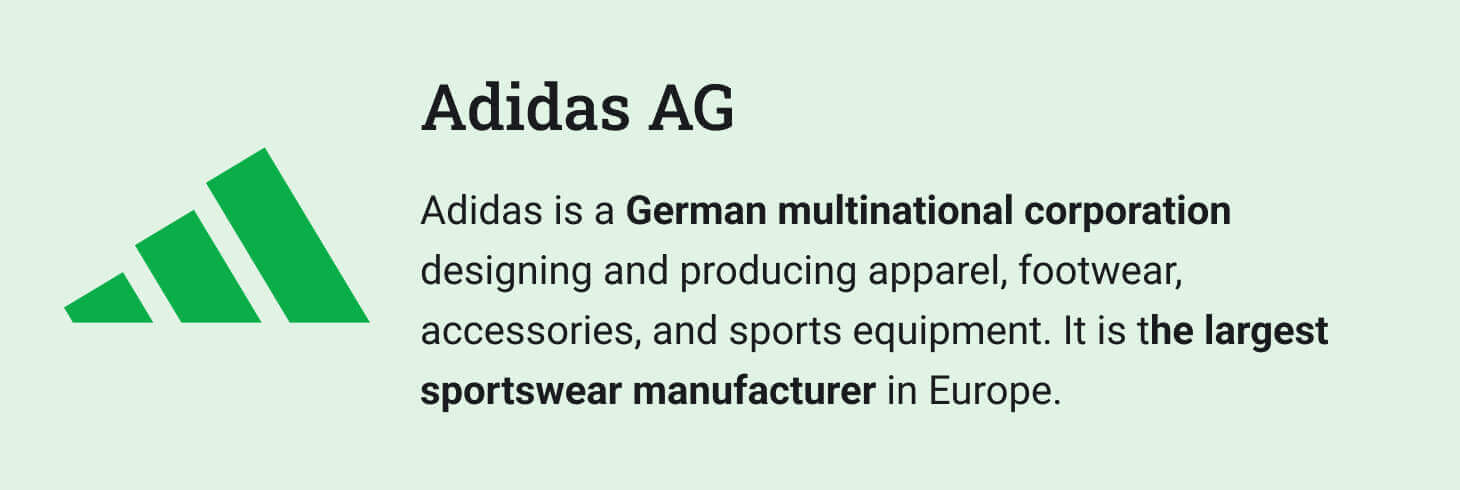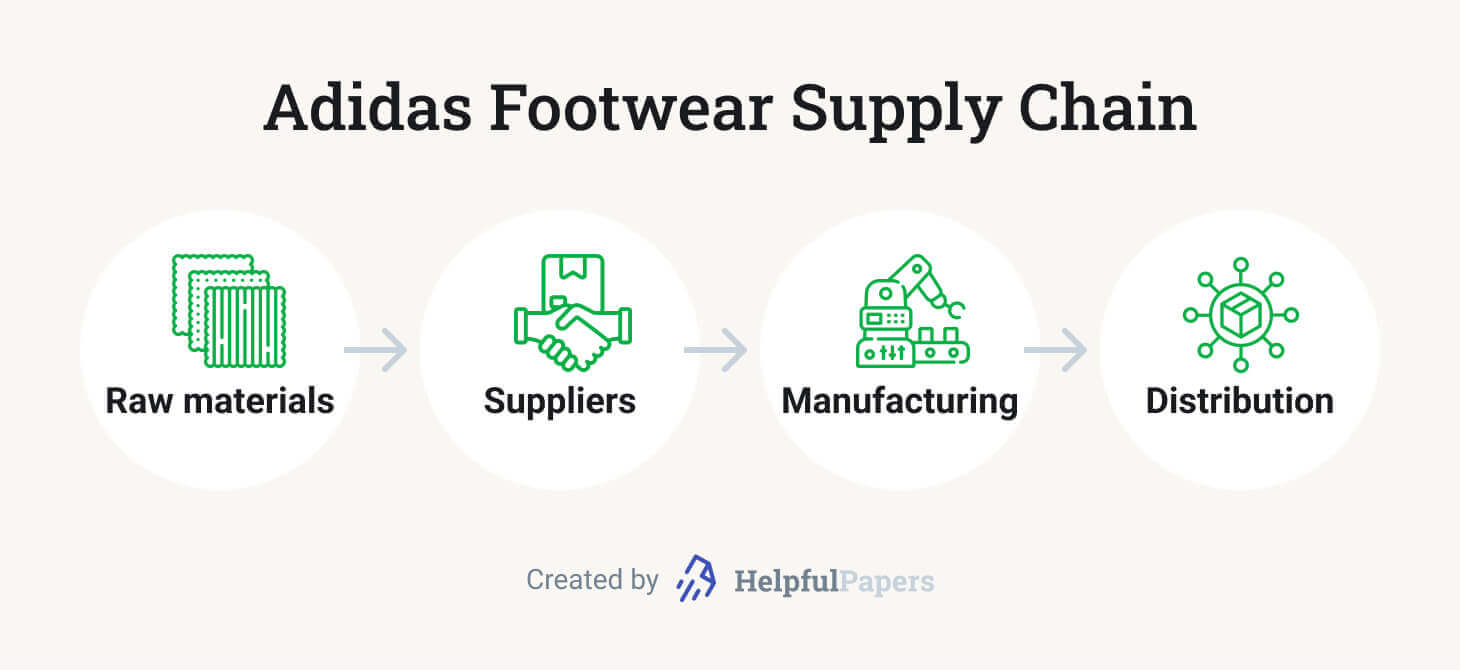
In 2023, the German sportswear maker Adidas AG celebrates its 74rd anniversary. After all these years into the game, the brand is as popular as ever. Adidas constantly improves its designs, collaborating with celebrities like Beyonce, Kylie Jenner, and Pharrell Williams. A student can learn many helpful business lessons from the Adidas case study!
🤔 5 Facts About Adidas People Don’t Know
- The company was founded in 1924 by Adolf Dassler, a shoemaker’s son. However, the most recognized trademark with the three stripes was not Dassler’s original idea. He purchased it from the Finnish shoe brand for two whiskey bottles and €1600.
- Adidas’s iconic sneakers “Stan Smith,” were initially named after Robert Haillet, the French tennis star. However, Stanely Smith was considered a better candidate to represent the tennis shoe model.
- There was a park in Boston called “Adidas Park,” where nobody but people with Adidas Adidas brand clothes were allowed.
- Adidas was the first to make a microchip for their sneakers to check the amount of calories athletes burn.
- Michael Jordan, the world-famous basketball player, almost signed a deal with Adidas before going for the Nike shoe brand.

💡 Adidas Case Study – Ideas for Any Taste
Numerous external and internal factors influence Adidas’ financial performance. When doing an Adidas case study, a student can focus on the company’s marketing approach, supply chain, or CSR policy. Here’re some more ideas!
- The history of Adidas company.
- Corporate values and mission.
- The role of Adidas’ executive board.
- Key products and collaborations.
- Manufacturing process.
- Supply chain.
- Strategic management.
- The global presence and market influence.
- Employment and internships at Adidas.
- E-commerce and digital marketing.
- Advertising campaigns.
- Target customers.
- Official sponsorship.
- Key market competitors of Adidas.
- Sustainability principles.
- Adidas’ environmental initiatives.
- Criticism of a company.
- CSR policy.
- Crisis management.
- Adidas’ financial figures.
📈 Adidas Marketing Plan
- Adidas uses marketing to build a bond with the audience
Adidas interacts with its customers with the help of social media and ads. It creates a strong bond that makes the customers come back for new purchases. The brand works to create excitement around the world of sports on a personal level. - Adidas takes inspiration from the cities
The company carefully determines which items sell better and in what specific areas. For example, in London, Adidas primarily focuses on selling soccer-related products. Meanwhile, the main product focus in New York is basketball or baseball. - Adidas collaborates with athletes
Collaborating with professional athletes helps Adidas enhance its creativity in branding. Adidas’ partnerships also include major music and fashion artists to reach out to people who are not into sports. For example, When Adidas had a deal with Kanye West to create Yeezy footwear, it became one of the most popular footwear lines in the industry.
☎️ Adidas Supply Chain Case Study
- An overview of Adidas’ supply chain
Adidas’ supply chain is global and diverse and deals with many business partners. The company operates in over 50 countries, working with over 700 independent manufacturers. Adidas has five broad categories of suppliers:- Subcontractors,
- Material providers,
- Licensees,
- Agents.
- Adidas’ Speedfactory
Speedfactory is a factory where robots do most of the work. Products are assembled using 3D printing, which increases the efficiency of mass customization. Compared to the months it takes to make a sneaker using the traditional supply chain, Speedfactory completes production in a few days. - Adidas’ Click and Collect program
To make the consumer experience easier, Adidas has created a multidimensional purchasing program—”Click and Collect“. It enables consumers to choose how they prefer to shop. For example, if the product a customer wants to order is available at the online shop, they can reserve it immediately and take it from any store.

📘 Adidas Case Study Ethics
- Adidas’ anti-discrimination policy
Adidas Company believes all employees have the right to work in a safe and respectful environment with equal opportunities. The company has a Legal & Compliance department that investigates all reported violations of the company’s policy. - Adidas’ integrated management system policy for health and safety
Adidas has created an integrated management system (IMS) approach to ensure all operations happen safely and healthily. This policy controls the performance of the whole organization, including all the brands and locations. - Adidas supporting the employees during COVID-19
When the pandemic hit, Adidas continued to pay workers during the shutdown period, including the migrant workers who could not return to their residences. Moreover, Adidas provided earlier cash and year bonuses to help workers meet their daily needs. - Adidas joining the fur-free initiative
In 2021, Adidas announced joining the global Fur-Free Retailer program. Frank Henke, senior vice president of sustainability at Adidas, says that the number of their vegan products is growing. For example, the famous sneakers Stan Smith and Superstar are already available as vegan versions.
🦖 Adidas Sustainability Strategy
- An overview of Adidas’ sustainability
Consumers ranked Adidas as number 53 out of the 100 most sustainable brands. While the brand is already seen as sustainable, there is still room for improvement. For example, Adidas promises that by 2025, nine out of ten of its products will be sustainable. - Adidas sustainability targets
Adidas applies the Three Loop Strategy when creating its products: sportswear is made from recycled materials, made to be remade, or made with renewable materials. By 2030, the company promises to reduce greenhouse gas emissions by 30%. - Adidas & Allbirds eco-collaboration
In 2020, Adidas and Allbirds announced a collaborative project to find solutions for reducing the industry’s emissions. Two sports brands also wanted to show that competitors can work together. They collaborated to create a running shoe that clocks in at just 2.94kg CO2 per pair. - Kermit the Frog in Adidas’ latest sustainability campaign
In 2021 Adidas released a 60-second commercial where Kermit talks about the danger of climate change. The loveable frog character says it’s not easy to be green. The campaign shows Adidas’ commitment to lowering its carbon footprint and using only 100% recycled polyester.

🤓 Adidas Crisis Management
- Adidas social media crisis
In 2017, on the second day of the Annual Boston Marathon, Adidas sent an email to all the participants, saying: “Congrats, you survived the Boston Marathon.” It was a huge mistake, considering that Islamic terroristic actions occurred four years earlier near the marathon’s finish line. It took Adidas less than four hours to publicly apologize on social media. - Adidas handling its PR crisis
In 2018, US prosecutors charged ten people, including Adidas’ director of global sports marketing, with bribery and fraud. When the scandal got public, Adidas’ share price dropped 2.5%. Soon Adidas responded via email, saying that the company is committed to ethical business practices and is ready to cooperate with the authorities. - Adidas losing out in China
After the Coronavirus pandemic, statistics reveal that Chinese shoppers prefer their local brands to Western companies. As a result of the boycott, Adidas’ sales there fell 16% in the second quarter. For now, Adidas assumes that the company will soon see a steady recovery in China.
📱 Adidas Social Media Case Study
- An overview of Adidas’ social media strategy
The most striking feature of Adidas’ branding strategy is that it’s more than selling sportswear. It’s about pitching a lifestyle. Adidas’ catchy taglines are one of the most recognized slogans of modern brands. Another characteristic is that Adidas has powerful collaborations with athletes, singers, and designers. - Adidas’ campaign “She Breaks Barriers”
This initiative began in 2019 from a social media post where Adidas asked athletes to share the challenges and barriers they face. Using the collected responses, they developed a campaign to address inequality for female athletes. The company’s goal is to give women in sports more visibility. - Adidas’ campaign “End Plastic Waste”
In 2020, Adidas started a massive social media campaign with the message “End Plastic Waste.” This hashtag is in the top 10 hashtags used by Adidas on Instagram. Later Adidas made a documentary on its YouTube channel about its contributions to ending plastic waste.

👟 Adidas Vs. Nike Case Study
- Adidas vs. Nike: technology difference
Adidas always puts quality over quantity, focusing on customer satisfaction. The company addresses many athletes to learn about their preferences. The most famous shoes made by Adidas are Ultraboost, Gazelle, Supernova. In the case of Nike, the company uses lighter materials such as polyester, rubber, and cotton. The brand also uses ZoomX technology to help consumers achieve high speed during running. - Adidas vs. Nike: the business model
Adidas’ business focuses on creating innovative products to fulfill customers’ specific needs. For example, the company has unique speed models in its supply chain, which helps Adidas to respond quickly to consumers’ needs. On the other hand, the main focus of Nike has been building solid and promising networks and partnerships with celebrity athletes like Michael Jordan. - Adidas vs. Nike: marketing strategies
Adidas opens its doors to all athletes and other consumers worldwide on its social media websites. The company has a “Calling All Creators” campaign to collect customers’ opinions and build new partnerships. In the case of Nike, the company heavily relies on its storytelling abilities. Their marketing campaigns are often built around telling real stories.
🎾 Adidas Vs. Reebok Case Study
- Adidas vs. Reebok: brands’ history
The story of Adidas begins in the 1900s in Bavaria, Germany when the founder Adolf Dassler started making running shoes for athletes. When Robert Louis Dreyfus became the new CEO, he bought the Reebok company in 2005.
Reebok was founded in Bolton, United Kingdom, by Joseph William Foster in 1958. The company aimed at making innovative footwear but only became wide-known after Adidas AG finally bought it. - Adidas vs. Reebok: materials and manufacturing
Adidas uses natural and synthetic materials for production. One of Adidas’s sustainable initiatives, “Made to be remade,” makes it possible to return worn-out shoes. Reebok has product lines made from plant-based materials, recycled plastic waste, and organic cotton. The company’s unique footwear technologies, like Reebok Pump, provide athletes with better traction. - Adidas vs. Reebok: pricing strategies
Price is an essential element of the marketing mix of Adidas. The brand charges premium prices for its high-quality products. Adidas’ sportswear is aimed at high-end customers. On the opposite, Reebok has a very flexible pricing policy. When the company introduces any new product, they keep a low pricing strategy until customers’ demand rises.
🔗 References
- What is supply chain management? | IBM
- Adidas | History, Products, & Facts | Britannica
- What Is the Executive Board of a Corporation? | Small Business – Chron.com
- (PDF) Sourcing Practices of Adidas | Vasant Kothari – Academia.edu
- adidas Sustainability | End Plastic Waste | adidas US
- Recycling Basics | US EPA
- SWOT Analysis: How To With Table and Example